An Unforgettable trail
Glentanner Station has been in the Ivey family for generations, with tourism entering the picture in 1978. Business was booming until Covid hit, when Helen and Ross Ivey were forced to pivot. The result was the development of one of the most magnificent short walks New Zealand has seen. Words & Photos Sarah Horrocks.
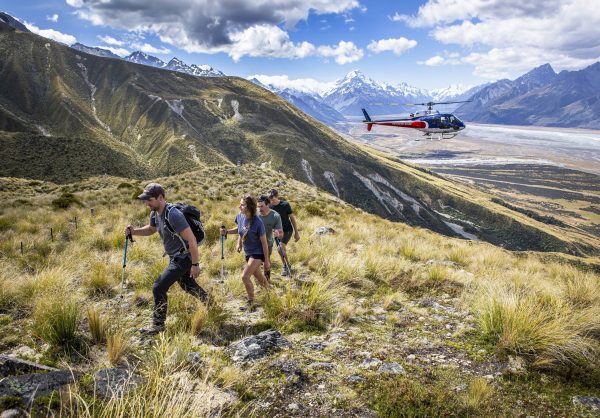
Walking among snow tussocks, lichen-smothered greywacke rocks, and breathing the purest of mountain air is the stuff of Kiwi gold. Add in views over the powder-blue water of Lake Pukaki, and the snow-capped Southern Alps with Aoraki Mount Cook front and centre, and you’ve got the recipe for the adventure of a lifetime.
Glentanner Station is owned by Ross and Helen Ivey, having been purchased by Ross’s father Ian Ivey in 1957. The 4,000-hectare freehold property is home to 6,000 merino sheep, with the farming operation run alongside the tourism business by son George Ivey and his wife Catherine.
Tourism has always been part of daily life for Ross and Helen, with the Glentanner Park Centre running adjacent to the station and bringing in the lion’s share of the total income. Accommodation, scenic flights, a retail shop focused on merino products and a café have attracted predominantly overseas visitors since it was established in 1978. Ross says farming merino is rarely viable on mountainous high-country land, in this case near the alps on the Main Divide. ‘It can be very wet, cold and with lots of snow so this is challenging for any livestock.’ Tourism is, therefore, the backbone of the operation.
When Covid hit our shores, it forced the family’s hand to diversify into tourism that was more tailored and appealing to the domestic market, since a 45-minute scenic helicopter flight is out of most New Zealanders’ budgets. ‘A short helicopter flight, followed by a walk in the high country seemed more appealing to Kiwi families,’ says Helen.
The proposed heli hike would take place over land that had always been inaccessible to the public so Helen and Ross hoped that at the very least, the locals would support the initiative. Once the idea was mooted it very quickly swung into life out of an urgency to get some income coming in post-Covid.
You realise just how special Glentanner is – a true jewel in the high country’s crown and being able to enjoy it as a member of the public is remarkable.
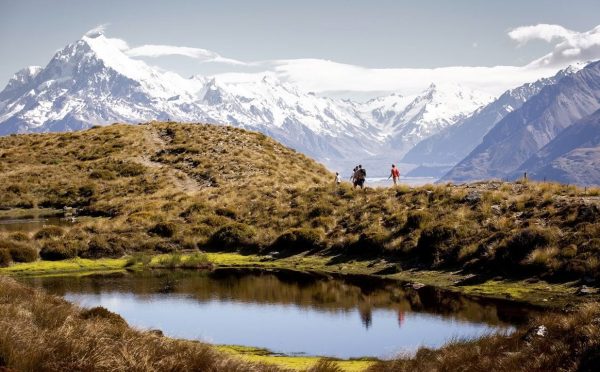
Ross says the initial pricing of $135 per person barely covered the helicopter costs, but they had to get momentum going and get people interested.
‘Sometimes you have to take an initial hit and provided we weren’t losing money on the hikes, a heli hike booking meant that those same guests were hopefully staying in our accommodation for a night,’ says Helen.
In the beginning, it was Ross guiding all the hikes himself. Guests loved the authentic feel of a Kiwi bloke with a dog whistle hanging around his neck, telling yarns of the high country and showing them his backyard – a privilege you might say. As the attraction grew in popularity, Ross, now in his mid-sixties, had to make the call to bring in another guide to help take the load off his knees. ‘Walking down hills day in and out isn’t as easy on the body as you might think,’ he laughs.
Matt Sutton was the first one schooled up over a few beers and he took to talking high-country chat like a duck takes to water – if there’s anything to know about Glentanner, Matt now knows it and the punters loved him. Matt had already been at Glentanner working in the accommodation for three years so he started guiding alongside Ross for a few months and then ventured out on his own with the hikers, allowing Ross’s knees the odd day off.
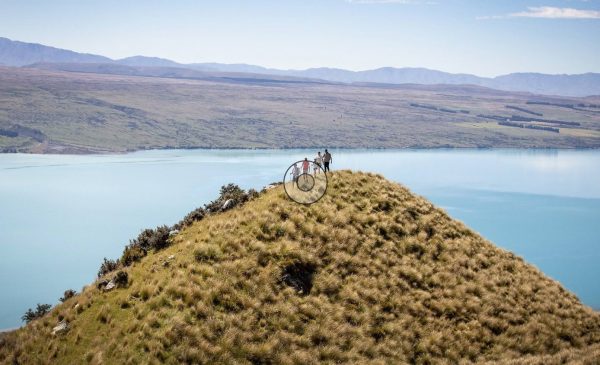 Dare to Dream
Dare to Dream
To take you on a bit of a short journey, let’s imagine you’re at Glentanner for a moment and after you’ve all been told how much (too much) Christmas pudding you ate during the weigh-in on the pre-flight scales, you’re ready to take flight …
The hike starts at Glentanner Park, where you’re loaded into a helicopter and lift off on a short ride. You travel out over the meandering Tasman River Delta and Lake Pukaki. The only difficulty in taking photos is to decide exactly what to point your camera at – the options are overwhelming – Aoraki to the west, Pukaki to the east, the Burnett Range to the north and Mount Dark and Glentanner to the south. Oh, and the delta directly below is beautifully mesmerising!
Current guide Brian Bezalel says that looking out over Lake Pukaki feels like you’re standing on the edge of the world, and you’re the only one in it.
A lucky few may even witness Himalayan tahr scaling rock faces and up over ridges on their way to the landing spot, which sits at about 1,000 metres above sea level on an ancient glacial moraine shelf.
The guide leaps out and hunkers down in the native tussock and snow grasses, pointing to the whirring rotor blades above. ‘Watch your heads,’ he yells. You file out one by one like eager school kids, hurriedly trying not to miss a moment of what’s happening. The helicopter beats like a drum as it peels off the hillside and back down to Glentanner Park and you’re left in silence. It’s not until then that you realise just how special Glentanner is – a true jewel in the high country’s crown and being able to enjoy it as a member of the public is remarkable.
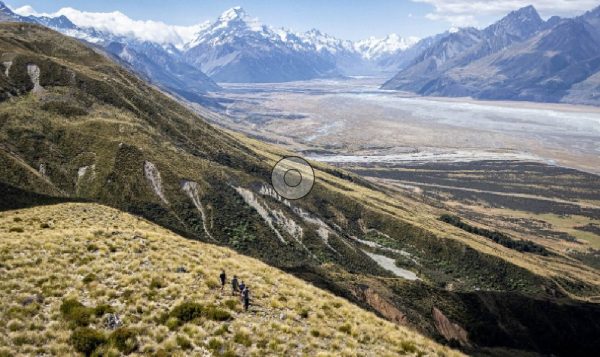
The Vision
Ross and Helen had more than just a spectacular vision – they wanted guests to learn about the land and geological features, the history, the flora and fauna, and they wanted to inspire people to look after the landscape.
Wilding pines are one example of Ross’s work in the wider community, acting as Chair of the Mackenzie Wilding Trust. More than a quarter of New Zealand is at risk of being smothered by wilding pines and that includes productive land, ancient native landscape and unique biodiversity.
In the local Mackenzie Basin, the wildings are a devastating problem, and both Ross and Helen are proud of the work they’ve done to ensure Glentanner doesn’t fall victim to that strangulating species of trees. ‘Glentanner has been kept free of wilding pines through good management and a lot of bloody hard work,’ he says.
As you wander along the heli hike route, it’s a good vantage point to see other areas of private and Department of Conservation land that are choking under their influence in the wider landscape. The contrast seen in Glentanner’s wide open faces of rock and tussock, with the odd merino thrown in for good measure, make Ross and the team’s hard work all the more evident. The seven-kilometre walk along the rocky farm track allows time to hear stories of the past, admire a New Zealand falcon or kārearea soaring on the north-west wind and even stop for a dip in one of the mountain tarns if your enthusiasm takes you there.
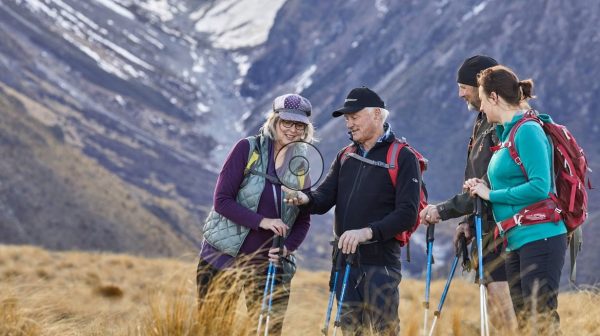
Current guide Brian Bezalel says that looking out over Lake Pukaki feels like you’re standing on the edge of the world, and you’re the only one in it.
A sharp descent takes you down to the newly restored historic field station museum. Here you take a break for either morning or afternoon tea and undoubtedly the highlight is Helen’s home-made muesli slice, washed down with a hot brew. Helen makes the slice in advance so her freezer is well stocked, however, she says she counts every slice and Ross’s idea of nibbling one with a glass of whisky in the evenings was very quickly banished.
Helen says the home-made slice is a simple touch of typical rural life and almost every group asks for the recipe. Has she given it out? ‘I decided to laminate it and put it on the wall in the hut to save the admin,’ she jokes.
The exhibition inside the field station huts tells stories of scientific research from the early days at Glentanner, and the relationship between Ross’s father Ian and the scientist who lived in the huts with his family.
‘We’ve created something that is genuine; that people never forget.’
Ross says both families considered it a privilege to play a part in this exceptional landscape, adjacent to Aoraki Mount Cook. ‘My parents, Ian and Pat Ivey (the farmers), and Dr Tony and Josianne Archer (the scientists), shared a strong friendship, mutual respect and understanding for their respective roles in the high country.’
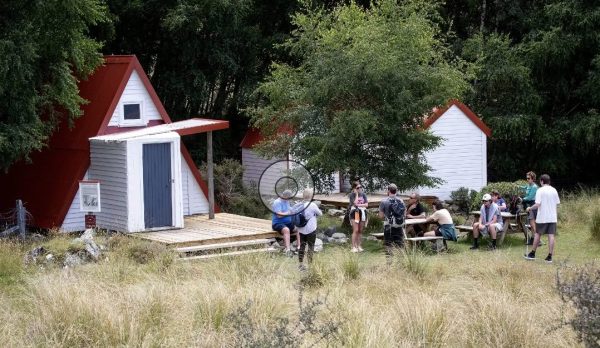
Helen says they decided to restore the huts to bring a more professional feel to the hike and when they decided to lift their pricing to meet the demand, they felt they needed to bring a superior product to the market. ‘People expect more than what they pay for; you need to exceed their expectations each and every time.’
And that they do. Designed by Auckland company Pearson & Associates, the huts were fitted out with lights, talking cupboards, exhibition-level displays of scientific soil samples, old tools and a great set of imagery showing the relationship between scientist and farmer. Far more than you’d expect when you see a few triangle-shaped huts and silver birch trees nestled into this vast, formidable landscape. ‘We wanted to do justice to the hard work and forward-thinking ability of the family who lived here,’ explains Ross. He says they endured cold harsh winters, often surrounded by snow for months at a time.
When the guests reach the huts, the back of the walk is well and truly broken, with just the last half hour taking you on an easier stroll down grassed tracks back to the main highway and Glentanner Park.
Helen says she loves seeing the guests come back in as they’re always beaming and that’s something she’s extremely proud of. ‘We’ve created something that is genuine; that people never forget.’
Authenticity is rare in this day and age. Social media fills minds with highlight reels of people’s lives and distorted views of how creators and marketers want people to perceive the world. One thing is certain – there is no need for filters at Glentanner; what you see in photos and videos can never justify just how remarkable this place is in real life. There are some experiences in life that you never forget, and this is one of them.

